Here’s a scenario for you: You’ve invested in a good LED light that can grow some corals, and you don’t want to jeopardize everything with the wrong aquarium livestock.
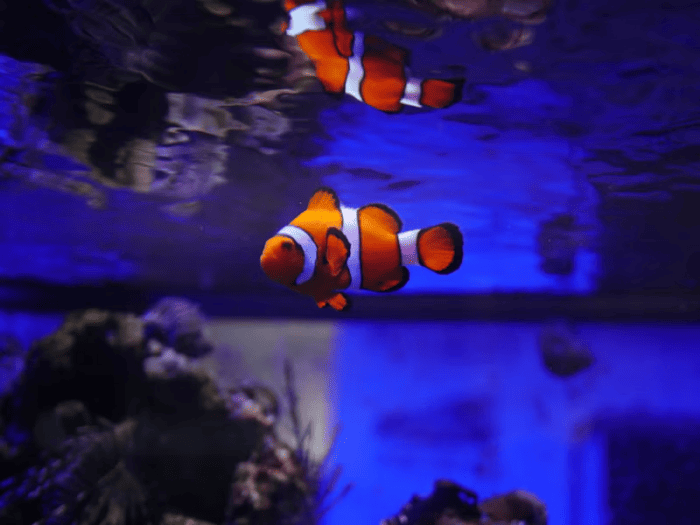
For such occasions, I’ve created a list of attractive, reef-safe fish that you can reliably keep in your tank, without putting your coral colonies in danger.
You will learn about saltwater fish that are peaceful and suitable for beginners, with the occasional species for more advanced aquarists.
In a reef tank, a truly safe fish would be considered one that has been known to never eat coral.
In my top selection, I’ve used this rule to sift out different species and only provide the best options.
I will also mention popular species that may be added to a reef tank with caution.
So let’s get started.
15 Truly Reef-Safe Fish That Won’t Harm Your Corals
There are many exotic-looking fish that won’t harm the corals in your reef tank. The following list includes the best peaceful or outgoing species and some others that may turn out to be loners.
I made sure to point out which is which, while also adding some specific guidance for the beginners.
Make sure to bookmark this post as you’ll see a lot of additional recommendations.
Here are some ideas for saltwater aquarium fish that are truly reef safe:
1. Flasher Wrasse Fish – Paracheilinus spp.
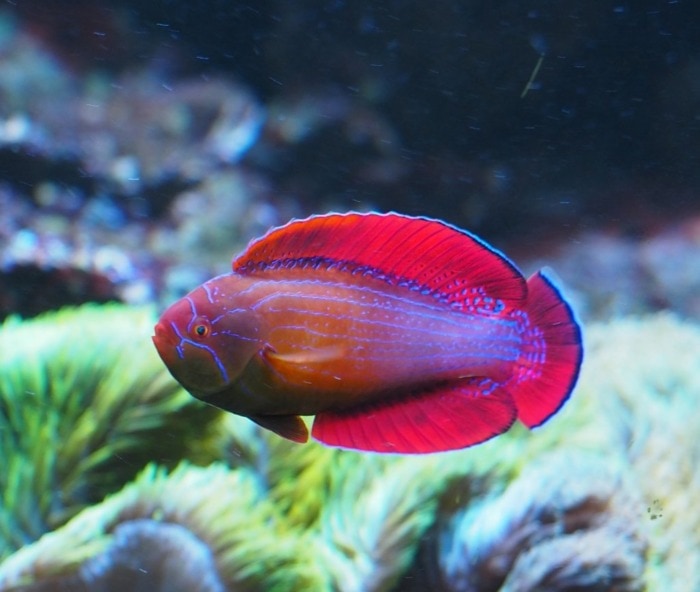
By OrionN
| Minimum Tank Capacity: | 50 gallons |
| Key Traits: | Peaceful; active; colorful; jumpers |
| Suitable for Beginners: | Yes, and I recommend trying it |
Most flasher, fairy, and lined wrasses are not only suitable but actually one of the best aquarium species for beginners. All Flasher Wrasse fish are extremely colorful and are worth looking into if you want beautiful fish for your reef tank.
Many species of the Paracheilinus genus remain small and peaceful, which makes them one of the best choices if you’re not starting out with a large tank.
The one you see in the picture above is known as an Eightline Flasher Wrasse and remains under 4.5 inches in adulthood.
Author’s note: Wrasse fish swim actively and have a short digestive system. This means that they will need to eat a couple of times per day to stay energetic.
Anyway, there are quite a few wrasse species, other than the Flasher ones, who won’t nip your corals and will leave invertebrates in the tank alone.

By Spideybry
Here are a few Wrasse fish species that will not harm corals in a reef aquarium:
- Tamarin Wrasses – Anampses sp.;
- Fairy Wrasses – Cirrhilabrus sp.;
- Cleaner Wrasses – Labroides sp.;
- Lined Wrasses – Pseudocheilinus sp., can be more aggressive;
- Possum Wrasses – Wetmorella sp.;
- Leopard Wrasses – Macropharyngodon sp.;
- Pencil Wrasses – Pseudojuloides sp.;
- Pink Streak Wrasses – Pseudocheilinops sp.;
- Halichoeres Wrasses – Halichoeres sp., larger specimens may eat ornamental shrimp.
2. Clownfish – Amphiprion spp.
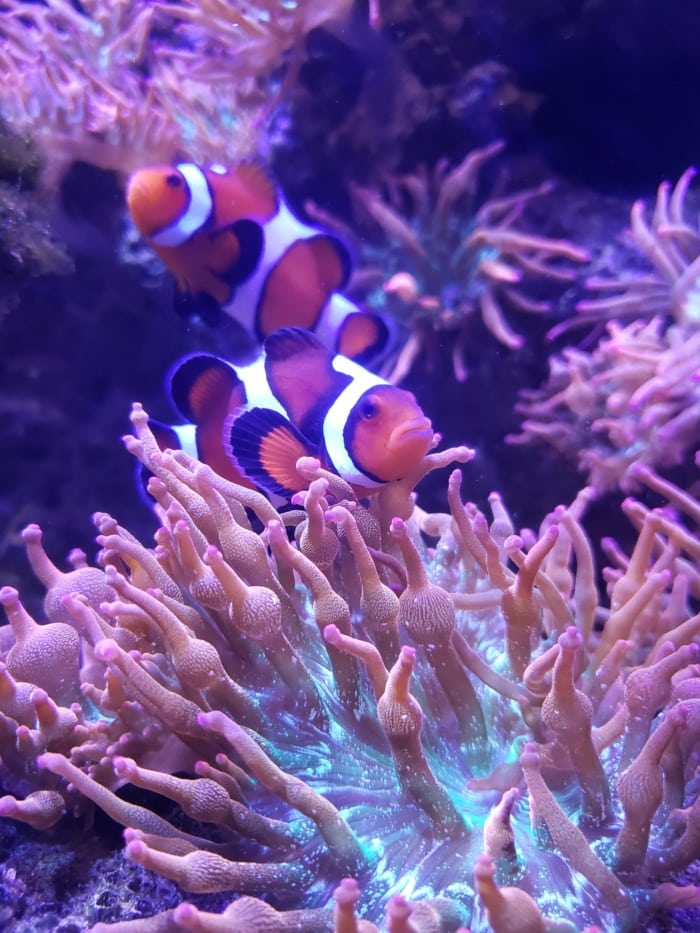
By ObviousGreen285
| Minimum Tank Capacity: | 20 gallons |
| Key Traits: | Hardy; has a huge personality and is not shy; eats almost anything; colorful |
| Suitable for Beginners: | Yes, especially the Ocellaris Clownfish, because it remains small and is relatively peaceful |
The Clownfish type has inspired Finding Nemo which, in turn, kickstarted the fish’s popularity among beginner reef tank owners.
Essentially, this species from the well-known Amphiprion genus is the closest you would get to a reef-safe fish.
This is because of the Clownfish’s unique way of life:
Clownfish have a symbiotic relationship with anemones.
Simply put, the Anemone protects the clownfish with its stinging tentacles, and the clownfish provides nutrients for the anemone in the form of waste.
There are 6 main species of Clownfish available in the saltwater aquarium trade. Visit the link to see them, and also discover 20+ designer corssbreeds. Almost all of them are beginner-friendly:
- Ocellaris;
- Maroon;
- Tomato;
- Percula;
- Clarkii;
- Skunk.
From these, I would recommend avoiding the Maroon Clownfish if you’re a beginner who doesn’t like dealing with extremely aggressive fish.
Maroon clowns are known to become very territorial in the presence of an anemone.
Also, because of their huge lifespan of over 20 years, Clownfish are a long-term commitment.
Want vibrant coral growth? Explore the best coral foods ideal for SPS and LPS corals.
3. Swallowtail Angelfish – Genicanthus spp.
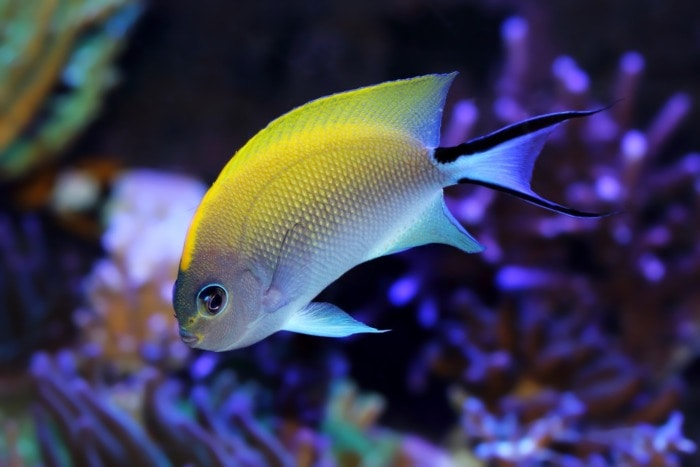
By Fadi Abu Tahoun
| Minimum Tank Capacity: | 125 gallons |
| Key Traits: | Very peaceful; moderate level of care; may be expensive; hardy |
| Suitable for Beginners: | No, most of these fish do require some experience with keeping saltwater aquariums |
The Spotbreast Swallowtail Angelfish is a gracious fish with delicate features, that needs a 125-gallon tank to swim comfortably.
That being said, the best thing about fish from the Genicanthus genus is that they are some of the few saltwater Angelfish species that are somewhat guaranteed to NOT eat coral in your reef aquarium.
Author’s note: The Genicanthus Angelfish species is collected from the deep and adult specimens may not adapt well to aquarium life, displaying buoyancy issues. For this reason, you should try to obtain a captive-bred juvenile if you want long-term success with these fish.
Anyway, some more popular Angelfish such as the Coral Beauty and the Flame Angelfish have a hit or miss status when it comes to reef safety.
These fish may or may not develop a taste for corals and there are plenty of reports from reef keepers observing both situations. It’s not fun to invest time and resources in reef tank lights that would grow expensive corals just to have your Coral Beauty take a bite out of the production.
The Swallowtails are the only Angelfish representatives that are truly reef safe.
4. Fang Blenny – Meiacanthus spp.

By Bongobasher
| Minimum Tank Capacity: | 30 gallons |
| Key Traits: | Has venomous fangs, but never uses them; non-aggressive; prefers meaty foods unlike other blennies; may not be safe with some invertebrates; needs a substrate; stays in the open |
| Suitable for Beginners: | Absolutely, but be sure to get a captive-bred specimen |
Though blennies are hit or miss when it comes to bothering SPS corals, the Fang Blenny seems to be one of the very few exceptions.
The Fang Blenny is a part of a genus named Meiacanthus, native to the western Pacific and Indian oceans.
Unlike other herbivorous blennies, the Fang Blenny prefers a main diet of meat, supplemented with very little Nori algae.
Contrary to what you may imagine, this fish is quite peaceful and will not use its venomous fangs on anything in the reef tank.
Anyway, another reef-friendly blenny would be the Midas Blenny, because it also leans on the carnivorous side.
However, the Midas blenny can be very aggressive towards other fish and is not a good addition to a reef tank with timid fish and invertebrates.
5. Atlantic Chalk Bass – Serranus tortugarum
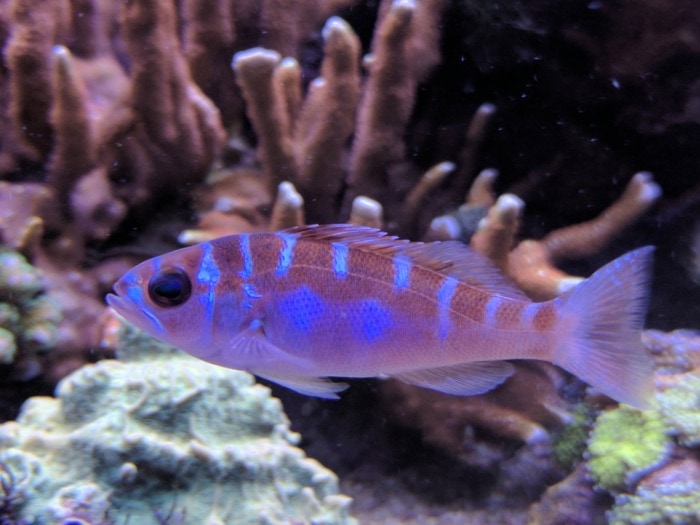
By BebopFlow
| Minimum Tank Capacity: | 30 gallons for a single specimen |
| Key Traits: | Aggressive feeder; jumper; peaceful and minds its own business |
| Suitable for Beginners: | Yes |
The Atlantic Chalk Bass is a saltwater fish that has the cool behavior of a Bass, but is also reef-safe and won’t bother corals.
This species from the Serranus genus stays relatively small with the normal being 3 inches and a maximum size of 4.5 inches.
If the tank is large enough, a group of these fish can form a small school.
Most likely the Chalk Bass won’t be aggressive towards its tank mates but may go for smaller shrimp.
Also, it may not get along with certain damsels and the Royal Gramma, which is also a type of Basslet.
Anyway, it’s a beautiful fish that needs to be more popular in the reef tank hobby.
Author’s note: The Chalk Bass fish is an aggressive surface feeder. It’s really amusing to watch it dash in split seconds to get its food. However, this means that you should feed on small portions to give the fish a chance to eat all of it. Food that sinks to the bottom will be overlooked by the Chalk Bass.
Anyhow, the Chalk Bass is not the only Basslet that would not harm corals.
Here are a few popular Basslets that can be safely kept in a reef aquarium:
- Royal Gramma – Gramma loreto;
- Black Cap Basslet – Gramma melacara;
- Captive-Bred Orchid Dottyback – Pseudochromis fridmani;
- Gold Assessor Basslet – this one is very peaceful – Assessor flavissimus;
- Randall’s Assessor Basslet – Assessor randalli;
- Macneill’s Assessor Basslet – Assessor macneilli;
- Swissguard Basslet – Liopropoma rubre.
6. Dispar Anthias – Pseudanthias dispar

By ASHWIN
| Minimum Tank Capacity: | 125 gallons |
| Key Traits: | Bold; outgoing personality; hardy; schooling; needs ample swimming space; relatively peaceful |
| Suitable for Beginners: | Yes |
The Dispar Anthias are the less-aggressive cousin of the Lyretail Anthias but have the same boldness coupled with an outgoing personality.
These species are from the largest Pseudanthias genus in their subfamily Anthiinae.
The cool behavior of the Dispar Anthias fish makes them a desirable addition to any large reef tank.
These brightly-colored fish like to be the center of attention and sometimes you can even see them schooling.
Another schooling Anthias fish that’s more popular for less aggressive reef aquariums is Randall’s Anthias.
Anyway, do your research on the aggression level your chosen Anthias species may display.
Some like the Dispar Anthias are peaceful, but Bartlett’s anthias, for example, can tear up members of their own kind in just days.
Here are some Anthias fish for large reef aquariums:
- Lyretail Anthias – Pseudanthias squamipinnis;
- Randall’s Anthias – Pseudanthias randalli;
- Ignitus Anthias – Pseudanthias ignitus;
- Evansi Anthias – Pseudanthias evansi;
- Carberryi Anthias – Nemanthias carberryi;
- Sunset Anthias – Pseudanthias parvirostris.
7. Blue-Green Chromis –Chromis viridis
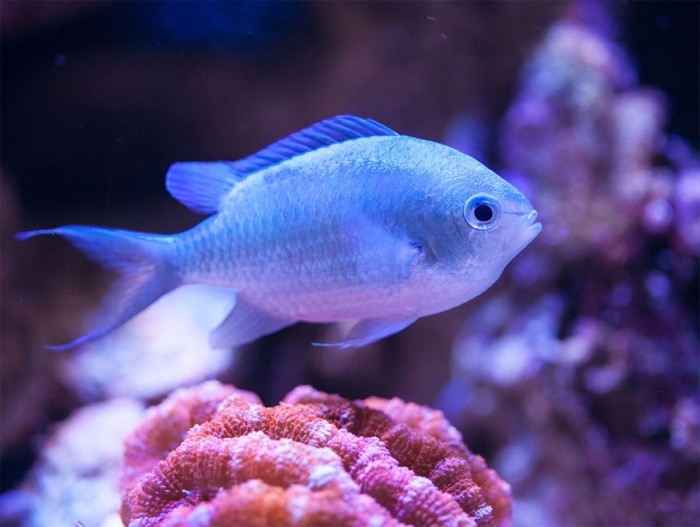
By rsav
| Minimum Tank Capacity: | 125 gallons for a group of 8 members |
| Key Traits: | Extremely social fish; needs to be in a group; very energetic and so needs a lot of food; can be aggressive among each other if not in a large enough group |
| Suitable for Beginners: | Yes, but the aquarist should read up on the fish beforehand |
The Blue-Green Chromis fish is often a desirable choice among beginners with large reef tanks, because of its schooling behavior and active way of life.
This species is a member of the Chromis genus which includes most of the fish known as damselfish.
These fish are not colorful enough to distract the viewer, and yet add plenty of overall movement to the tank.
Because Blue-Green Chromis are so active that you need to feed them multiple times a day or they will start to perish one by one.
These are sensitive fish that are prone to aggression and conditions such as Ich and other nasty diseases when not in a large enough group. And though a reef-safe treatment of Ich is possible, you don’t want that kind of disease in your display tank, nor do you want aggressive Chromis fish.
Author’s note: It’s relatively difficult to find long-term success with these fish, especially if you’re a beginner in the hobby. In my experience, what helps is:
- keeping a group of 8 or more;
- having increased flow in the middle-top part of the water column;
- feeding the Chromis fish 3 or more times a day.
All of this reduces the potential aggression to manageable levels, which keeps the school safe and healthy. Make sure that your reef tank is equipped with strong powerheads and stick to the feeding regimen.
Here are some more Chromis fish that will be a good addition to your new reef aquarium:
- Barrier Reef Chromis – Chromis nitida;
- Blue Reef Chromis – Chromis cyaneus;
- Black and White Chromis – Chromis margaritifer;
- Black Bar Chromis – Chromis retrofasciata;
- Sunshine Chromis – Chromis insolata.
8. Falco Hawkfish – Cirrhitichthys falco
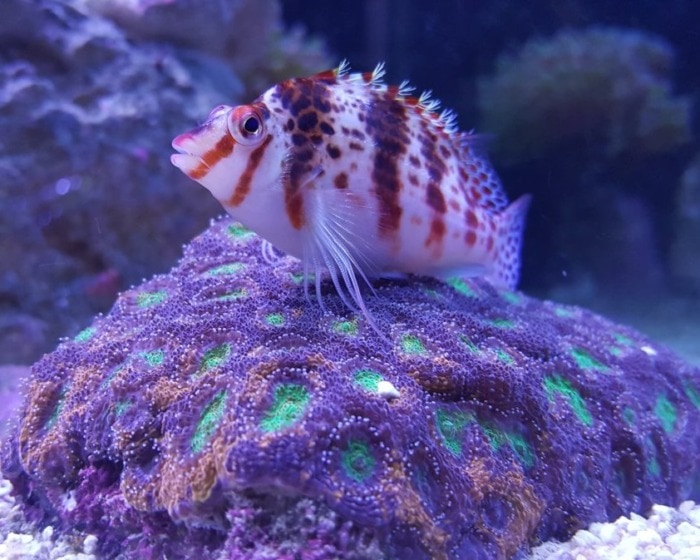
By Murrel
| Minimum Tank Capacity: | 30 gallons |
| Key Traits: | Predatory and will eat shrimp; hardy; semi-aggressive; interesting behavior and personality; jumper |
| Suitable for Beginners: | Yes |
The exceptionally beautiful Falco Hawkfish is a predatory saltwater fish that can be a very entertaining member of a reef tank.
Typical for the members of Cirrhitichthys genus, the Falco Hawkfish use the “sit and wait” technique to ambush their prey.
These fish are generally peaceful, but may sometimes bully Basslets or Clownfish, though this is not the norm with them.
Aside from that, Hawkfish really are predatory and will likely eat any shrimp and nano fish that are small enough to be considered prey.
This includes cleaner shrimp and other Clean Up Crew members.
Your corals, on the other hand, will be safe as this fish is strictly carnivorous.
The only possible damage to hard corals would be from the Hawkfish perching on them to patrol its hunting grounds.
However, there would be no long-term damage.
That being said, here are some species of Hawkfish that would safely fit in a reef aquarium:
- Flame Hawkfish – Neocirrhites armatus;
- Longnose Hawkfish – Oxycirrhites typus;
- Pixy Hawkfish – Cirrhitichthys oxycephalus;
- Freckled Hawkfish – Paracirrhites forsteri;
- Arc Eye Hawkfish – Paracirrhitus arcuatus.
9. Red Firefish Goby – Nemateleotris magnifica
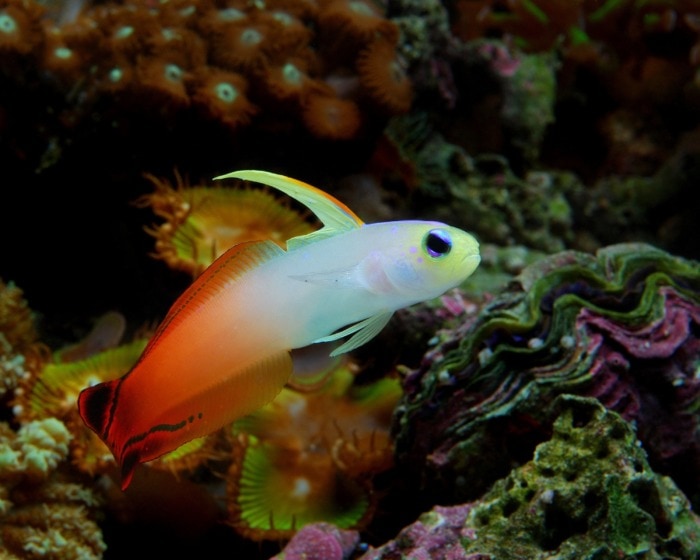
By TurboMP
| Minimum Tank Capacity: | 20 gallons |
| Key Traits: | Peaceful but bold; uniquely colored; remains small |
| Suitable for Beginners: | Yes |
The Red Firefish Goby is a nano reef fish that has a unique appearance and is truly safe around corals.
This species within the Nemateleotris genus inhabits Indian and Pacific oceans.
Most firefish gobies stay small in size and have contrasting bright colors that could definitely make them the best centerpiece fish in your nano tank. Anyway, the temperament of the Red Firefish Goby is peaceful towards other species.
However, some aggression may arise among firefish gobies, unless they are a bonded pair.
The Red Firefish Goby needs to have many hideouts throughout the aquarium which would give it more confidence.
Though this species is less skittish than its cousins, you could always go for another type of firefish as most of them are very pretty.
Here are some firefish that you can try keeping in a nano reef tank:
- Helfrichi Firefish Goby – Nemateleotris helfrichi;
- Purple Firefish Goby – Nemateleotris decora;
- Exquisite Firefish Goby – Nemateleotris exquisita.
10. Pajama Cardinalfish – Sphaeramia nematoptera
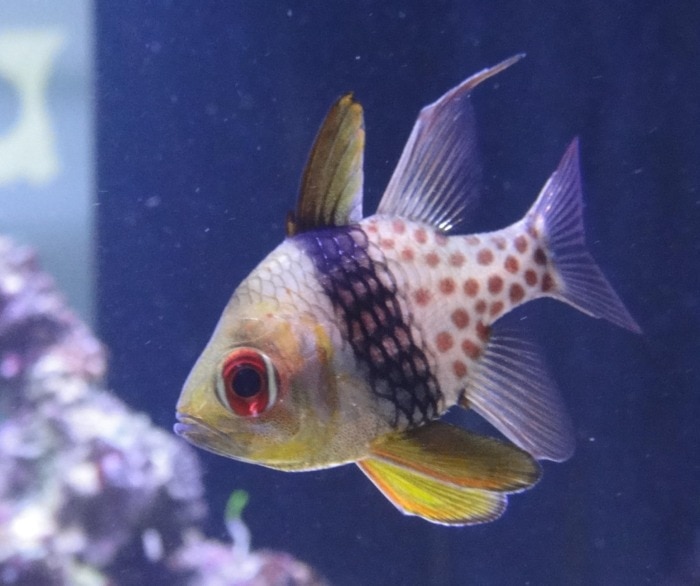
| Minimum Tank Capacity: | 30 gallons |
| Key Traits: | Certain species may school together; looks somewhat surrealistic; calm swimmer; peaceful with its tank mates |
| Suitable for Beginners: | Yes |
The Pajama Cardinalfish is a good choice for reef keepers who want a more exotic-looking fish that may school together.
This marine fish belongs to the Sphaeramia genus, the species of which are distributed throughout shallow tropical reefs in the Indian and Pacific Oceans.
Though all Cardinalfish are reef-friendly it should be noted that there species that are less likely to tolerate each other such as the Banggai Cardinal.
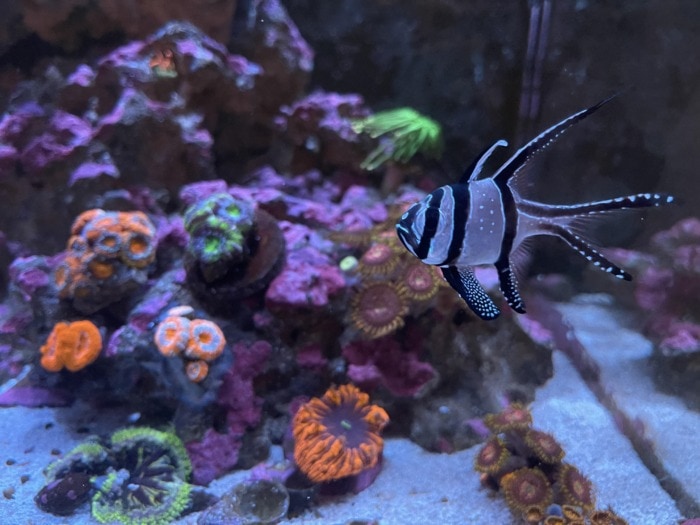
By theneonreef
Pajama Cardinalfish are less aggressive overall and still look good in a reef aquarium.
If you’re a beginner who aims at having schooling fish that are not aggressive among each other, I recommend going for the Longspine Cardinalfish ( Zoramia leptacantha).
Longspines are less attractive per se, but are very friendly and keep a group at all times, which can be desirable for a display aquarium.
Author’s note: It’s easier to get captive-bred Cardinalfish to eat.
Here are some Cardinalfish to check out that will be safe around reef corals:
- Orbiculate Cardinalfish – Sphaeramia orbicularis;
- Banggai Cardinalfish – Pterapogon kauderni;
- Flame Cardinalfish – Apogon maculatus;
- Red Spot Cardinalfish – Apogon parvulus;
- Ring-tailed Cardinalfish – Ostorhinchus aureus;
- Ochre Striped Cardinalfish – Ostorhinchus compressus.
11. Quoyi Parrotfish – Scarus quoyi
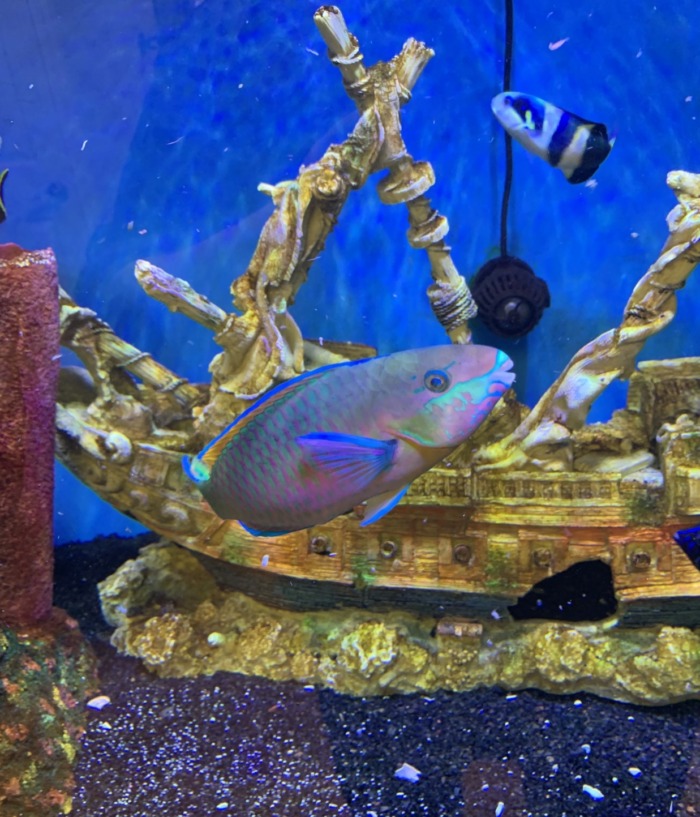
By tkiry1
| Minimum Tank Capacity: | 150 gallons |
| Key Traits: | Is among the most beautiful saltwater fish in my opinion; eats all kinds of marine algae; can be messy; needs peaceful tank mates |
| Suitable for Beginners: | No |
The Quoyi Parrotfish, from the very numerous Scarus genus, is one of the very few large parrotfish species that won’t nibble rock corals in your aquarium.
It’s a voracious saltwater algae eater and it produces a lot of waste in a closed system such as a reef tank. This sizable fish will eat algae by scraping it off your rocks almost constantly.
When that’s gone, the Quoyi Parrotfish will need to eat algae sheets or wafers to remain healthy. Needless to say, this type of fish is not ideal for dedicated planted marine aquariums.
Anyway, bear in mind that these fish can be difficult to keep long-term.
Do your research before going for the big Quoyi Parrotfish.
12. Marine Betta – Calloplesiops altivelis
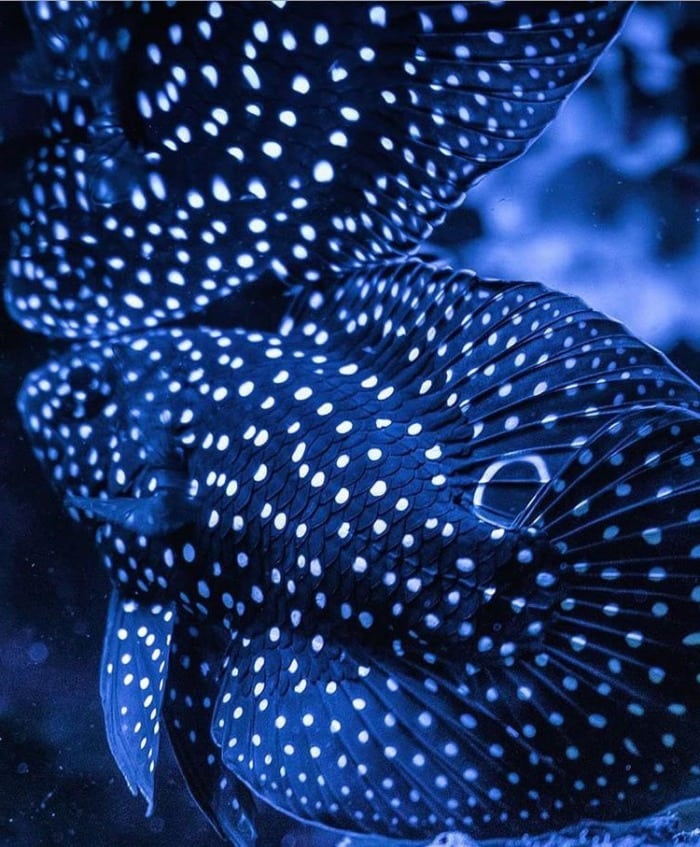
By squarepusher6
| Minimum Tank Capacity: | 55 gallons because this fish does very little swimming |
| Key Traits: | Needs caves in its aquarium; prefers to eat more but only a few times a week; peaceful; may try to prey on smaller shrimp, though not necessarily |
| Suitable for Beginners: | Yes |
The Marine Betta is a fantastic reef-safe fish that needs to be more popular.
Coming from the Calloplesiops genus it is native to the Indo-Pacific region.
In a reef tank, it will be really peaceful and it will stay away from conflict.
The Marine Betta needs its own lair in the aquarium where it could retreat from time to time.
It is not an active fish and, in general, it will prefer to stay in the same spot in your tank.
Caution should be exercised if you have dwarf shrimp, as these fish are predators.
However, it is not guaranteed that the Marine Betta will show interest in the invertebrates.
13. Dwarf Lionfish – Dendrochirus biocellatus
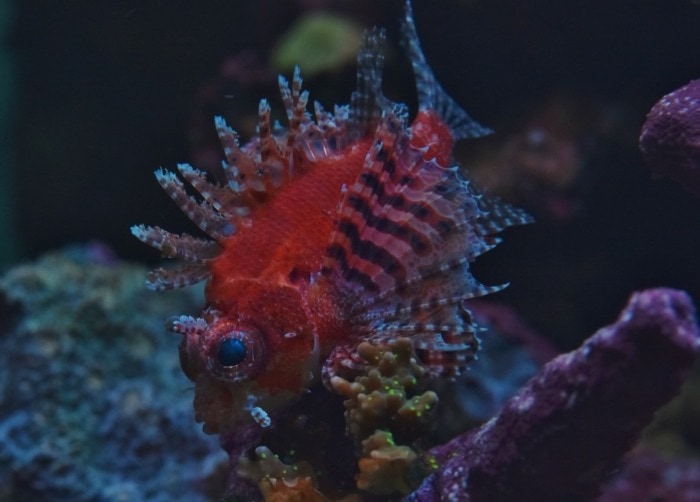
By najer
| Minimum Tank Capacity: | 50 gallons |
| Key Traits: | Needs a good amount of hideouts; is predatory and will eat anything that fits in its mouth; has a venomous sting so it should be handled with caution |
| Suitable for Beginners: | Some experience with managing aggressive marine fish is needed |
When it comes to living in a reef tank, the unique-looking Dwarf Lionfish are completely coral safe since they have a carnivorous diet.
The Dwarf Lionfish are part of the Dendrochirus genus, native to the Indian and Pacific Oceans.
They are also known as turkeyfish or pygmy lionfish.
Nevertheless, their diet is what you may be concerned about when deciding if you want one in your aquarium.
They are predatory fish that will definitely eat anything that fits in their mouths.
The dwarf Lionfish is a good addition to a predatory reef aquarium with well-thought tank mates.
The best approach is to choose a small Lionfish species such as the Fu Manchu Lionfish.
Here are other relatively small Lionfish to choose from for your saltwater aquarium:
- Fuzzy Dwarf Lionfish – Dendrochirus brachypterus;
- Dwarf Zebra Lionfish – Dendrochirus zebra;
- Hawaiian Lionfish – Dendrochirus barberi;
- Antennata Lionfish – Pterois antennata.
14. Zebra Barred Dartfish – Ptereleotris Zebra

By Snow_Phoenix
| Minimum Tank Capacity: | 30 gallons |
| Key Traits: | Active swimmer that will reside at the top of the water column; peaceful; can be kept in a school, pair or as a lone specimen |
| Suitable for Beginners: | Yes |
Even though it is often referred to as a Zebra Barred Goby, this tiny reef-safe fish actually belongs to the Ptereleotris genus of dartfish.
And after you spend some time with it, you’ll clearly see why that is.
Unlike the more “grounded” behavior of gobies, Zebra Barred Dartfish are active swimmers that spend most of their time at the top of the water column.
The cool thing about these fish is that you can keep them in a school, pair or alone.
They’re extremely peaceful, so even if you have a school and some of the fish pair up, they still won’t exhibit any aggressive behavior.
Their calm disposition makes them a great fish for a saltwater community tank.
They’ll easily get along with Pajama Cardinal Fish, Watchman Gobies and small fish that won’t get intimidated by their fast swimming.
It’s important to note that Zebra Barred Dartfish should be kept under a tight lid as they might try to dart past you if you’re not careful.
Especially during feeding time.
In terms of diet, these tiny rascals will highly appreciate a variety of live and frozen protein such as mysis and brine shrimp.
15. Yellow Watchman Goby – Cryptocentrus Cinctus

By Mania25
| Minimum Tank Capacity: | 30 gallons |
| Key Traits: | Lacks aggression towards other fish and is tough; substrate sifter, great for community tanks; can form a symbiotic relationship with shrimp. |
| Suitable for Beginners: | Yes |
The Yellow Watchman Goby (Cryptocentrus Cinctus) is one of the best saltwater fish for beginners.
It’s not fussy about food, has minimal space requirements and won’t bother any of your corals.
It’s also quite peaceful (albeit a bit timid at times), so it will get along with most fish that don’t view it as a snack.
The only exception to this rule is the occasional scuffle it might have with others of its kind.
Interestingly enough, the generous nature of watchman gobies extends beyond the limits of their taxa.
These well-meaning fish tend to form a symbiotic relationship with shrimp from the alpheus genus.
Since these shrimp have poor eyesight, they are an easy target for predators.
However, when they pair up with a watchman’s goby, they receive a helping “fin” which warns them about potential threats.
In return, they reward the goby with a cozy spot in their burrow.
Popular Saltwater Fish That May or May Not Eat Corals

By greekspec2
Apparently, there are some saltwater fish that are too interesting to pass on. These species may be fine for a week or 2 years before deciding to bite large chunks off of your corals.
That being said, you can find many reports of reef tank owners who keep said fish for years with no issues.
The fish that I’m about to list should be considered a hit or miss when it comes to eating coral.
Also, the following entries should be kept in large tanks with enough mature corals so that the damage stays relatively small and is recoverable with time.
Coral Frag tanks may or may not be destroyed by these denizens.
Here are some fish that should be added to a reef aquarium with caution:
- Mature Tangs may become interested in eating zoanthids, acans, and, sometimes, Xenia;
- The Aiptasia-Eating Filefish are not completely safe for a reef tank and sometimes snack on clams or zoanthids, but some users do report success with them;
- The Pyramid Butterflyfish is your best bet for a reef safe butterflyfish, but is not guaranteed to leave corals alone;
- The Tailspot blenny and other blennies will sometimes munch on SPS corals;
- Triggerfish are known for their aggression and tendency to cause havoc in a reef tank, but if you’d like to try one you should likely go for the Crosshatch Trigger Fish(Xanthichthys mento);
- Puffer fish are all considered to be unsafe for reef tanks but, if you’ve set your mind on one, you can try the Valentini Puffer and expect minimal SPS coral and clam losses;
- Popular Angelfish such as the Flame Angel will eventually take a bite of your corals or clams, but can likely be managed with a strict feeding schedule;
- The Foxface and other Rabbitfish may turn to nipping your LPS and soft corals if underfed.



